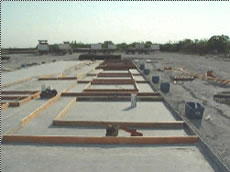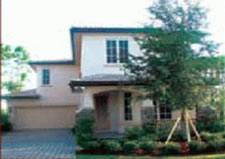|
This custom builder planned to build a large energy efficient
custom home in New York with photovoltaic (PV) grid-connected
panels. Discussions began on optimizing electrical energy
use and including solar water heating panels for household
water. The builder planned to use gas appliances wherever
possible and a floor radiant heating system (pump energy
is one-third that for a fan air distribution system). FSEC
recommended a solar water heating system with gas backup
and forwarded information on two solar water heater designs
available from Duke Solar. FSEC also provided several choices
in heat recovery ventilator (HRV) units which would provide
200 CFM of outside air.
New
construction drawings were received and EnergyGauge USA
analysis results were discussed with the builder and Alten
Design, since PV grid-interconnect requirements and architectural
changes were needed to accommodate the PV panels. FSEC’s PV group laid out a 7 kW PV system that included
4.5 kW’s of flat roof panels (unique for a residential
application) and sent information to the architect. This
activity ended in 2002 with no home construction.
This
builder has gone from Florida energy building code minimum
homes to being committed to build over 250 homes in two
new sub-divisions that meet the BA goal of a HERS score
of 88.6 or above. Each home will be serviced with a "right-sized" Seer
14 heat pump with a variable speed air handler, double pane
low-E windows with a SHGC of .36 or less, passive OA system
and a programmable thermostat. Each home will be performance
tested and commissioned.
- Top of the World Retirement Community
Florida H.E.R.O. worked with project managers in charge
of On Top of the World Central, a retirement community
in Ocala developed by Sidney and Kenneth Colen who have built
15,000+ homes for senior citizens and have a commitment to
developing communities that meet the needs and desires of
that unique population.
Project managers of On Top of the World Central have
every home performance tested for duct and whole house air
tightness. Other features of the homes are summarized in Table
19.
This is the largest plotted sub-division in Florida, with
over 24,000 homes slated to be built. Top of the World has
gone from code minimum construction to Energy Star.
Table 19 On
Top of the World Characteristics |
Component |
Specification |
Conditioned area |
1120-2093 sq. ft. |
HERS Score |
86-89 |
Mechanical and System |
Engineered and right sized
systems
Engineered duct design
|
Heating |
Standard 80% AFUE furnace |
Cooling |
SEER 12 AC |
Ducts |
Mastic sealed and tested |
Duct Leakage |
CFM25
out < 5%
of AHU flow |
Wall |
Block with steel interior
framing |
Windows |
Double pane |
- Trinity Construction Corporation
|
Figure
29 Panel forms on forming bed |
|
Figure
30
Setting pre-castconcrete wall panel |
Trinity
Construction Corporation is a large shell contractor serving
Florida homebuilders. Faced with increasing demands for
higher quality, lower cost and more timely delivery, Trinity
is actively exploring innovative alternatives to conventional
concrete block construction, the predominant homebuilding
technology in the central and south Florida market. Trinity
operates a pre-cast concrete panel production facility,
in South Bay, Florida where concrete panels are pre-cast (Figure 29), transported to the construction
site, and quickly assembled using a construction crane (Figure
30). The UCF Housing Constructability Lab (HCL) was
asked to assist Trinity in improving the current panelizing
process by incorporating lean production principles such
as "just in time" materials handling.
Preliminary research involved extensive observation and
analysis. Value stream mapping, a process to isolate waste
and production efficiency opportunities, identified activities
that contributed value to the customer as well as activities
that added little or no value. Material handling and rework
were primary contributors to the 47% of labor consumed by
non-value added activities. Once construction started, the
flow of value-added activity was routinely interrupted. Poor
access to materials and tools, rework, ill-defined process
flows, and workforce/1 st line supervision issues were contributing
factors. To address these issues, BAIHP researchers utilized
lean production principles - challenging non-value added
activities and removing the obstacles to continuous production
flow. Recommendations addressed issues of organization/communication,
structured procedures and work flow, material handling, and
off-line sub-assembly.
Table
20 Panel Productivity in Square Foot of Wall per
Labor Hour |
Process Phase |
"Tested
Sample"
Process
|
Potential
Process Results
|
Pilot
Test
Process
|
Productivity
Increase
During Test
|
Layout |
53 |
152 |
91 |
72% |
Prep |
52 |
149 |
79 |
52% |
Pouring |
146 |
211 |
296 |
103% |
Lifting |
75 |
440 |
75* |
0% |
Total |
17 |
49 |
25 |
47% |
*Not altered
during pilot test. |
To test the recommendations, Trinity allowed BAIHP researchers
to perform a 3-day pilot test. The test involved a single
house consisting of 25 panels. The panels had a total of
21 window and door openings and a gross wall area of 3,119
ft 2. The first day was used to organize and train the test
production team. The second and third days were dedicated
to production. All 25 panels were produced. Productivity
increased (Table 20) for all observed activities.
Lifting productivity was not observed. Conservatively assuming
that lifting activity will remain at historical levels, overall
labor productivity increased by 47% during the Pilot Test.
If lifting productivity is assumed to increase at the average
rate observed for the other activities, overall productivity
increase of the Pilot Test would be 68%. Not all recommendations
could be realized during the test. Some equipment and personnel
issues could not be resolved on a short-term test basis.
This suggests that the true potential is significantly greater
than that observed during the Pilot Test – possibly
approaching 200% increase in labor productivity. Corresponding
cycle time reductions are estimated to be 20-25%.
The BAIHP research team recommended that Trinity precede
with implementation of the lean production recommendations.
In addition to the technical recommendations, the research
team also made recommendations involving worker empowerment,
dealing with the heat and sun, and material/equipment availability.
Potential future research areas include covers for the production
area, on-site factories in new home developments, and factory
installed wall insulation. This successful pilot test has
given Trinity the opportunity to develop a competitive advantage
in the housing construction market and a solid foundation
to gain dominance.
Vincent Village is a 49 home rental community, located in
Richland, WA. All of the homes are small, single section
HUD Code homes, heated and cooled by Insider heat pumps.
Half the homes were built to Super Good Cents standards,
the other half were not. Metered utility data indicate average
yearly savings of $241 for the SGC homes. (See also Appendix
D, WSU)
During the fourth budget period, in November of 2002, BAIHP
staff members were planning to meet with WCI to discuss a
partnership. Because of their corporate environmental mission,
WCI plans to build a significant number of homes to the Florida
Green Home Designation Standard and has requested the help
of Building America to ensure a systems engineering approach,
to conduct efficiency monitoring, and to offer staff training.
WCI constructs approximately 2,000 homes per year across
south Florida. In 2002 they committed to having houses incorporate
a variety of green principles. In some WCI communities, every
home will meet the Florida Green Standard.
|
| Figure
32 WCI Home in Evergrene Community,
Palm Beach
Gardens (FL), HERS Score = 92. |
FSEC
received sample home plans and conducted an energy analysis
using EG USA. Recommendations were adopted by WCI (Table
21) for a model “green home” in the Evergrene
Community (Figure 32) in Palm Beach Gardens (FL).
BAIHP monitored progress on the prototype and installed monitoring
instrumentation in April 2003 (fifth budget period).
The home and the instrumentation were completed in August
2003. A device called
WebDAQ was installed, which acts as
a server to provide an internet web page to display real
time data as part of WCI's community education approach.
WCI maintains a website dedicated to the home at www.greengeneration.org.
In September 2003, WCI held a grand opening at Evergrene.
Staff from BAIHP and the DOE Atlanta Regional Office attended
the event which included tours of the home and a program
of distinguished speakers such as local government and business
leaders.
This
prototype “green home” received
the highest score to date on the Florida Green Home Designation
Standard. With a HERS score of 92, it is estimated to save
31% compared to the Building America benchmark home and
38% compared to the HERS reference home on a whole house
basis.
In February 2004, FSEC staff visited the Venetian Development
in Venice, FL developed and built by WCI Communities, Inc.
Over 1,000 homes will be constructed in Venetian, and all
will meet the requirements of the Florida Green Home Designation
Standard.
Table
21 WCI Evergrene Community - Green Home Model Specifications |
Conditioned Area |
1460 sq ft |
HERS Score |
92 |
Envelope |
Above-grade Wall |
ICF - first floor; 2X6 with Icynene
- second floor |
Attic |
Unvented, insulated at roof deck w/Icynene |
Roof |
Tile |
Windows |
Laminated Impact Resistant with SHGC
= 0.42 |
Equipment |
Ducts |
Sealed with mastic; Located in unvented
(Insulated) attic |
Heating & Cooling |
Variable speed SEER 15 with strip electric
heating |
Thermostat |
Programmable thermidistat |
Water Heater |
Conventional gas unit with EF=0.62 |
Lighting |
CFL and fiber optic lighting with occupancy
and daylight sensors |
Appliances |
Energy Star |
Indoor Air Quality |
Extensive VOC source control through
paint, cabinet, and counter top selection |
Ventilation |
Passive fresh air duct to mechanical
closet; Whole house filtration with UV sterilization |
Green Features |
Lumber |
All lumber certified sustainable, treated
lumber is ACQ, other lumber is engineered |
Water Conservation |
Dual flush toilets, automatic faucets,
drought tolerant landscape, micro irrigation, rainwater
harvesting. |
Resource Efficiency |
Eco-friendly flooring and finishes
Construction waste management plan
|
In
addition, WCI constructed another "ultra green" model.
WCI consulted BAIHP during the initial planning stages, and
this home was expected to have higher performance and contain
more green features than the Evergrene Community home. WCI
took the initiative to develop in-house expertise and capabilities
in this area and needed much less support from BAIHP. BAIHP
did involve IBACO, another BA Team, to help develop an advanced
lighting design.
|


 You
are here:
You
are here: 

